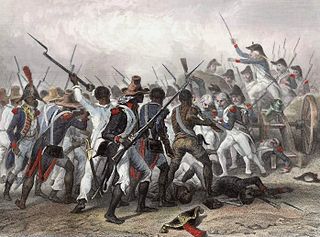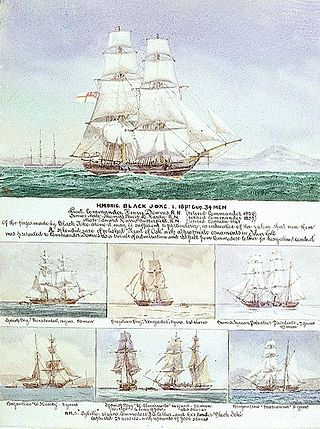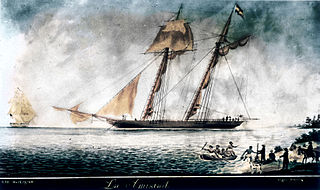Related Research Articles
Sierra Leone first became inhabited by indigenous African peoples at least 2,500 years ago. The Limba were the first tribe known to inhabit Sierra Leone. The dense tropical rainforest partially isolated the region from other West African cultures, and it became a refuge for peoples escaping violence and jihads. Sierra Leone was named by Portuguese explorer Pedro de Sintra, who mapped the region in 1462. The Freetown estuary provided a good natural harbour for ships to shelter and replenish drinking water, and gained more international attention as coastal and trans-Atlantic trade supplanted trans-Saharan trade.

The Atlantic slave trade or transatlantic slave trade involved the transportation by slave traders of enslaved African people, mainly to the Americas. The outfitted European slave ships of the slave trade regularly used the triangular trade route and its Middle Passage, and existed from the 16th to the 19th centuries. The vast majority of those who were transported in the transatlantic slave trade were from Central and West Africa who had been sold by West African slave traders mainly to Portuguese, British, Spanish, Dutch, and French slave traders, while others had been captured directly by the slave traders in coastal raids; European slave traders gathered and imprisoned the enslaved at forts on the African coast and then brought them to the Americas. Except for the Portuguese, European slave traders generally did not participate in the raids because life expectancy for Europeans in sub-Saharan Africa was less than one year during the period of the slave trade.

United States v. Schooner Amistad, 40 U.S. 518 (1841), was a United States Supreme Court case resulting from the rebellion of Africans on board the Spanish schooner La Amistad in 1839. It was an unusual freedom suit that involved international diplomacy as well as United States law. The historian Samuel Eliot Morison described it in 1969 as the most important court case involving slavery before being eclipsed by that of Dred Scott v. Sandford in 1857.

Amistad is a 1997 American historical drama film directed by Steven Spielberg, based on the events in 1839 aboard the Spanish slave ship La Amistad, during which Mende tribesmen abducted for the slave trade managed to gain control of their captors' ship off the coast of Cuba, and the international legal battle that followed their capture by the Washington, a U.S. revenue cutter. The case was ultimately resolved by the U.S. Supreme Court in 1841.

Bunce Island is an island in the Sierra Leone River. It is situated in Freetown Harbour, the estuary of the Rokel River and Port Loko Creek, about 20 miles upriver from Sierra Leone's capital city Freetown. The island measures about 1,650 feet by 350 feet and houses a castle that was built by the Royal Africa Company in c.1670. Tens of thousands of Africans were shipped from here to the North American colonies of South Carolina and Georgia to be forced into slavery, and are the ancestors of many African Americans of the United States.

Sengbe Pieh, also known as Joseph Cinqué or Cinquez and sometimes referred to mononymously as Cinqué, was a West African man of the Mende people who led a revolt of many Africans on the Spanish slave ship La Amistad in July 1839. After the ship was taken into custody by the US Revenue-Marine, Cinqué and his fellow Africans were eventually tried for mutiny and killing officers on the ship, in a case known as United States v. The Amistad. This reached the U.S. Supreme Court, where Cinqué and his fellow Africans were found to have rightfully defended themselves from being enslaved through the illegal Atlantic slave trade and were released. The US government did not provide any aid to the acquitted Mende People. The United Missionary Society, a black group founded by James W.C. Pennington, helped raise money for the return of thirty-five of the survivors to Sierra Leone in 1842.

The West Africa Squadron, also known as the Preventative Squadron, was a squadron of the British Royal Navy whose goal was to suppress the Atlantic slave trade by patrolling the coast of West Africa. Formed in 1808 after the British Parliament passed the Slave Trade Act 1807 and based out of Portsmouth, England, it remained an independent command until 1856 and then again from 1866 to 1867.
Tecora was a Portuguese slave ship of the early 19th century. The brig was built especially for the slave trade although the transport across the Atlantic of human beings as slaves had already been outlawed by several nations in international treaties in the first decade of the 19th century. She was fast and maneuverable in order to evade British patrols that attempted to stop such illegal slave ships off the coast of Africa.

La Amistad was a 19th-century two-masted schooner owned by a Spaniard living in Cuba. It became renowned in July 1839 for a slave revolt by Mende captives who had been captured and sold to European slave traders and illegally transported by a Portuguese ship from West Africa to Cuba, in violation of European treaties against the Atlantic slave trade. Spanish plantation owners Don José Ruiz and Don Pedro Montes bought 53 captives in Havana, Cuba, including four children, and were transporting them on the ship to their plantations near Puerto Príncipe. The revolt began after the schooner's cook jokingly told the slaves that they were to be "killed, salted, and cooked." Sengbe Pieh unshackled himself and the others on the third day and started the revolt. They took control of the ship, killing the captain and the cook. Three Africans were also killed in the melee.
The liberated Africans of Sierra Leone, also known as recaptives, were Africans who had been illegally enslaved onboard slave ships and rescued by anti-slavery patrols from the West Africa Squadron of the Royal Navy. After the British Parliament passed the Slave Trade Act 1807, which abolished Britain's involvement in the slave trade, the Admiralty established the West Africa Squadron to suppress the trade in cooperation with other Western powers. All illegally enslaved Africans liberated by the Royal Navy were taken to Freetown, where Admiralty courts legally confirmed their free status. Afterwards, they were consigned to a variety of unfree labor apprenticeships at the hands of the Nova Scotian Settlers and Jamaican Maroons in Sierra Leone. During the 19th century, it has been estimated by historians that roughly 80,000 illegally enslaved Africans were liberated by the Royal Navy.
Pedro Blanco (1795–1854) was a notorious Spanish slave trader based in Gallinas on the coast of Sierra Leone between 1822 and 1838. Before entering the slave trade, Blanco ran a sugar mill in Cuba.

James Benjamin Covey was a sailor, remembered today chiefly for his role as interpreter during the legal proceedings in the United States federal courts that followed the 1839 revolt aboard the Spanish slave ship La Amistad. Covey, who spoke Mende and English, was instrumental for enabling the Mende passengers of the Amistad to communicate with the court and to defend themselves successfully against charges of mutiny and murder.
The Tuckers of Sherbro are an Afro-European clan from the Southern region of Sierra Leone. The clan's progenitors were an English trader and agent, John Tucker, and a Sherbro princess. Starting in the 17th century, the Tuckers ruled over one of the most powerful chiefdoms in the Sherbro country of Southern Sierra Leone, centered on the village of Gbap.
Vice Admiral Joseph Denman was a British naval officer, most noted for his actions against the slave trade as a commander of HMS Wanderer of the West Africa Squadron.
HMS Nimble was a Royal Navy 5-gun schooner-of-war. She was employed in anti-slave trade patrol from 1826 until 1834, when she was wrecked on a reef with the loss of 70 Africans who had been rescued from a slave ship.

The Capture of Veloz Passagera was a single-ship action that occurred during the British Royal Navy's anti-slavery blockade of Africa in the early and mid 19th century. The sloop-of-war HMS Primrose, of 18 guns, under Captain William Broughton, captured the 20-gun Spanish slave ship Veloz Passagera, Jozé Antonio de la Vega, master.
The Gallinas River in Sierra Leone reaches the Atlantic between Cape Saint Ann and Grand Cape Mount.
James Cropper (1773–1840) was an English businessman and philanthropist, known as an abolitionist who made a major contribution to the abolition of slavery throughout the British Empire in 1833.
HMS Saracen was a Cherokee-class brig-sloop of the Royal Navy. Launched 30 January 1831 at the Plymouth Dockyard, at Plymouth, England, this vessel held a gun deck of eight 18-Pounder carronades and two 6-Pounder bow chasers. She also held a crew complement of 75. Henry Worsley Hill served as her commander starting on 15 March 1841.
References
- 1 2 Lawrance, Benjamin Nicholas (2015). Amistad's Orphans: An Atlantic Story of Children, Slavery, and Smuggling. Yale University Press. p. 118. ISBN 978-0-300-19845-4.
- ↑ Rediker, Marcus (2012). The Amistad Rebellion: An Atlantic Odyssey of Slavery and Freedom. Penguin. ISBN 978-1-101-60105-1.
- ↑ Grayson, Robert (2011). The Amistad . Edina, Minn.: ABDO Pub. p. 7. ISBN 978-1-61714-761-6.
royal navy lomboko 1849.
- ↑ Zafiris, Anna (2010). The Representation of African Americans in Steven Spielberg's 'Amistad'. München: GRIN Verlag. p. 4. ISBN 978-3-640-52511-9.